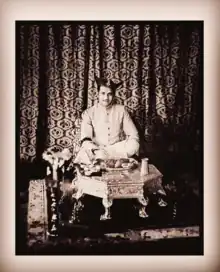| Jayabaraje Mukne | |||||||||||||
|---|---|---|---|---|---|---|---|---|---|---|---|---|---|
| Founder of Jawhar State and Mahalakshmi Temple, Dahanu | |||||||||||||
 H.H Maharaja Yashwantrao Martandrao Mukne, Direct descendant of Jayaba Mukne and last ruler of Jawhar | |||||||||||||
| Reign | 1306 - 1343 | ||||||||||||
| Successor | Raja Nemshah Mukne | ||||||||||||
| Regent | Nemshah Mukne | ||||||||||||
| Kuldevi | Mahalakshmi of Dahanu in Maharashtra | ||||||||||||
| Born | Jagappa Nayak Mukane, Maharashtra | ||||||||||||
| Died | June 1343 Old Jawhar Plalce, Rajawada, Jawhar town, Jawhar State | ||||||||||||
| Spouse | Rani Mohanabai (princess of the Koli kingdom of Dharamgad) | ||||||||||||
| Issue |
| ||||||||||||
| |||||||||||||
| House | Mukne dynasty | ||||||||||||
| House | Jai Vilas Palace (Jawhar Palace) | ||||||||||||
| Dynasty | Mukne | ||||||||||||
| Religion | Hindu | ||||||||||||
| Occupation | Nayak of Mahadev Kolis of Mukane fort | ||||||||||||
The Jayaba or Jaideoraoji Mukne, also known as Paupera and Jagappa Nayak Mukne, was first Koli ruler of Jawhar State. His name was also spelled as Jayaba Mukne, Jayaba Mookna, Jayab Mookney, Joya Mookney, Jayab Mukne, and Jayaba Mukna. He founded the Jawhar State and Mukne Dynasty in 1306 which ruled for over six hundred years, till 1947.[1][2][3][4]
History

Mukne built the Mahalakshmi Temple, Dahanu on the installation of the flag of Jawhar.[5] According to peoples, he had a small mud fort at Mukane near Tal pass as a Polygar. Once, visiting at a shrine at Pimpri, he was blessed by five mendicants and saluted as Raja of Jawhar. Thereupon he marched northwards and was acknowledged by peoples of Peint and Dharampur. He went to Surat and as far north as Kathiawar in Gujarat. There he remained for seven years. On his return from Kathiawad, he went to Jawhar and conquered it. He married Rani Mohanabai of Dharmagad. Rani gave birth to two sons named Nem Shah and Holkar Rao Mukne. After his death, he was succeeded by his elder son Nem Shah on 5 June 1343. Nem Shah was recognized as a Raja of Jawhar and given the title of Shah by Sultan of Delhi Sultanate Muhammad bin Tughluq.[6][7][8]
References
- ↑ Cunha, Joseph Gerson Da; Cunha, Joseph Gerson (1876). Notes on the History and Antiquities of Chaul and Bassein. Thacker, Vining. p. 257. ISBN 9788120608450.
Jagappa Mukne.
- ↑ Nairne, Alexander Kyd (1988). History of the Konkan. Asian Educational Services. ISBN 978-81-206-0275-5.
- ↑ Dept, India Foreign and Political (1876). Bombay presidency. Re-printed at the Foreign Office Press.
- ↑ Selections from the Records of the Bombay Government. Government at the Bombay Education Society's Press. 1856.
- ↑ Tribhuwan, Robin D. (2003). Fairs and Festivals of Indian Tribes. Discovery Publishing House. ISBN 978-81-7141-640-0.
- ↑ Gazetteer of the Bombay Presidency: Tha'na (2 pts.). Government Central Press. 1882. p. 703.
Jayaba Mukne.
- ↑ Aberigh-Mackay, George (1878). The Native Chiefs and Their States in 1877: A Manual of Reference. Times of India Steam Press. p. 69.
Jayaba Mukna.
- ↑ "JAWHAR". members.iinet.net.au. Archived from the original on 2 October 2019. Retrieved 28 November 2019.